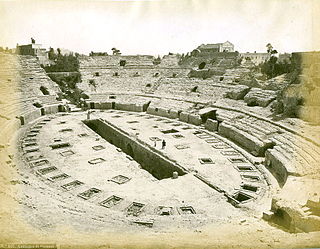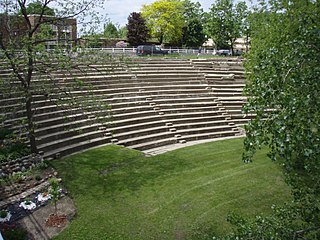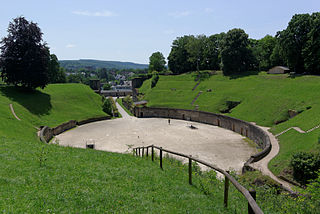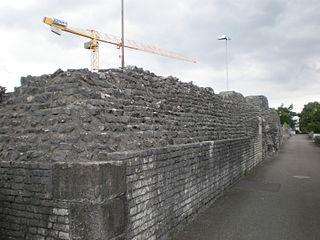
An amphitheatre or amphitheater is an open-air venue used for entertainment, performances, and sports. The term derives from the ancient Greek ἀμφιθέατρον, from ἀμφί, meaning "on both sides" or "around" and θέατρον, meaning "place for viewing".

The Pula Arena is a Roman amphitheatre located in Pula, Croatia. It is the only remaining Roman amphitheatre to have four side towers entirely preserved. It was constructed between 27 BC and AD 68, and is among the world's six largest surviving Roman arenas. The arena is also the country's best-preserved ancient monument.

The North Island Credit Union Amphitheatre is a 20,500-seat amphitheatre located in Chula Vista, California adjacent to Sesame Place San Diego. It is one of the larger concert venues in the San Diego area. The venue is currently owned and operated by Live Nation.

Shoreline Amphitheatre is an outdoor amphitheater located in Mountain View, California, in the San Francisco Bay Area. The venue has a capacity of 22,500, with 6,500 reserved seats and 16,000 general admission on the lawn. When the parking lot is utilized for festival stages, the total capacity of the venue can reach 30,000. The venue has hosted popular music festivals such as Lollapalooza and Ozzfest, and also developer conferences such as the Google I/O.

Lixus is an ancient city founded by Phoenicians before the city of Carthage. Its distinguishing feature is that it was continuously occupied from antiquity to the Islamic Era, and has ruins dating to the Phoenician, Punic, Mauretanian, Roman and Islamic periods.

The Arles Amphitheatre is a Roman amphitheatre in Arles, southern France. Two-tiered, it is probably the most prominent tourist attraction in the city which thrived in Ancient Rome. The towers jutting out from the top are medieval add-ons.

The Flavian Amphitheater, located in Pozzuoli, is the third-largest Roman amphitheater in Italy. Only the Roman Colosseum and the Amphitheatre of Capua are larger. It was likely built by the same architects who previously constructed the Roman Colosseum. The name "Flavian Amphitheater" is primarily associated with the Roman Colosseum.

Iulia Constantia Zilil was an ancient Roman-Berber city in Dchar Jdid, located 40 km southwest of Tangier and 13 km northeast of Asilah. It was one of the three colonias in Mauretania Tingitana founded by emperor Augustus between 33 and 25 BC for veterans of the battle of Actium.

Windego Park Auditorium/Open Air Theater is an amphitheater in Anoka, Minnesota, located on the Rum River. The theater was built in 1914 and was spurred by the City Beautiful movement, as well as Anoka citizens' interest in outdoor entertainment and recreation. Its main organizer, Thaddeus P. Giddings, was a promoter of music education and had been organizing community singalongs in the summer of 1913. The theater is listed on the National Register of Historic Places.

The Amphitheatre of Pompeii is one of the oldest surviving Roman amphitheatres. It is located in the ancient city of Pompeii, near Naples, and was buried by the eruption of Vesuvius in 79 AD, that also buried the city of Pompeii and the neighbouring town of Herculaneum.

Roman amphitheatres are theatres — large, circular or oval open-air venues with raised seating — built by the ancient Romans. They were used for events such as gladiator combats, venationes and executions. About 230 Roman amphitheatres have been found across the area of the Roman Empire. Early amphitheatres date from the Republican period, though they became more monumental during the Imperial era.

The Amphitheatre of Mérida is a ruined Roman amphitheatre situated in the Roman colony of Emerita Augusta, present-day Mérida, in Spain. The city itself, Emerita Augusta, was founded in 25 BC by Augustus, to resettle emeritus soldiers discharged from the Roman army from two veteran legions of the Cantabrian Wars. The amphitheatre itself was completed in 8 BC. The term emeritus refers to the soldiers, all of whom had been honorably discharged from service. The city became the capital of the Roman province of Lusitania.

The Trier Amphitheater is a Roman amphitheater in Trier, Germany. It is designated as part of the Roman Monuments, Cathedral of St. Peter and Church of Our Lady in Trier UNESCO World Heritage Site as a testimony to the importance of Trier as a major Roman city north of the Alps.

The Tours amphitheater is a Roman amphitheatre located in the historic city center of Tours, France, immediately behind the well known Tours cathedral. It was built in the 1st century when the city was called Caesarodunum. It was built atop a small hill on the outskirts of the ancient urban area, making it safe from floods, convenient for crowds and visitors, and demonstrating the power of the city from a distance. The structure was an enormous, elliptical structure approximately 122 meters by 94 meters. According to its design it is classified as a "primitive" amphitheatre. Unlike the famous Colosseum that was made mostly of masonry and built above-ground, the Tours amphitheatre was made mostly of earth and created by moving soil and rock into a bowl shape. Spectators likely sat directly on the grassy slopes, while the masonry was primarily used for the vomitoria and retaining walls.
An amphitheatre is an open-air venue used for entertainment, performances, and sports.

The Amphitheatre of El Jem is an oval amphitheatre in the modern-day city of El Djem, Tunisia, formerly Thysdrus in the Roman province of Africa. It is listed by UNESCO since 1979 as a World Heritage Site.

The Roman amphitheatre of Italica is a ruined Roman amphitheatre situated in the Roman settlement of Italica, present-day Santiponce, in Andalusia, Spain.

The Amphitheatre of Catrum Rauracense is the youngest known surviving Roman amphitheatre across the entire Roman Empire. It is located in the ancient Roman fort of Castrum Rauracense, near Kaiseraugst, Switzerland and only ruins survive today. It is the eighth Roman amphitheatre discovered in Switzerland to date.


















